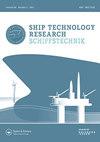Self-aligning behaviour of a passively yawing floating offshore wind turbine
IF 0.9
Q3 ENGINEERING, MARINE
引用次数: 9
Abstract
ABSTRACT Floating offshore wind turbines are a promising concept for expanding offshore wind energy. In comparison with fix-founded offshore wind turbines, the overall costs are less dependent on water depths, which leads to a variety of potential locations and markets worldwide. Furthermore, floating platforms allow for new structural designs with the potential to save material and installation costs. In this paper, a self-aligning platform equipped with a 6 MW turbine is presented. The platform is moored on a single point and uses a turret buoy to be able to rotate freely around its anchor point. A downwind rotor and an airfoil-shaped tower induce self-aligning turning moments to passively follow changes of the wind direction. The first order boundary element method panMARE is used to simulate the motion behaviour considering aerodynamic, hydrodynamic and mooring loads. The self-aligning capability is demonstrated under partial turbine load for steady and dynamic conditions with waves and current.被动偏航浮动海上风力涡轮机的自对准行为
浮动式海上风力涡轮机是拓展海上风能的一个很有前途的概念。与固定式海上风力涡轮机相比,总体成本对水深的依赖性较小,这导致了全球范围内的各种潜在地点和市场。此外,浮动平台允许新的结构设计,有可能节省材料和安装成本。本文介绍了一种配备6MW汽轮机的自对准平台。该平台系泊在一个点上,并使用转塔浮标,以便能够围绕其锚点自由旋转。顺风旋翼和翼型塔架诱导自对准转动力矩,被动地跟随风向的变化。一阶边界元法panMARE用于模拟考虑空气动力学、水动力和系泊载荷的运动行为。在波浪和水流的稳定和动态条件下,在部分涡轮机负载下证明了自对准能力。
本文章由计算机程序翻译,如有差异,请以英文原文为准。
求助全文
约1分钟内获得全文
求助全文

 求助内容:
求助内容: 应助结果提醒方式:
应助结果提醒方式:


